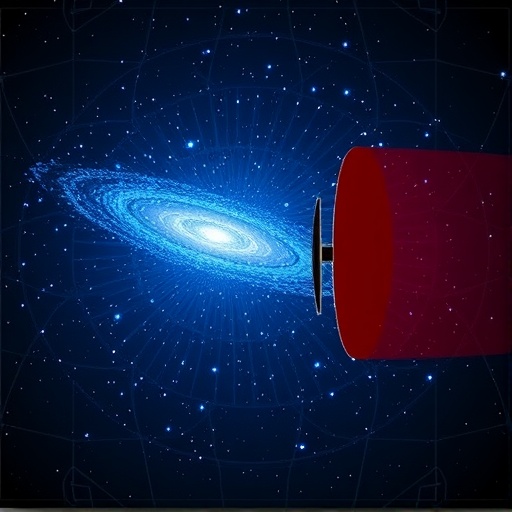The quest to uncover the enigmatic essence of dark matter has recently taken a significant leap forward with the deployment of an advanced detector nestled deep under the French Alps. The innovative device, crafted by an international consortium of researchers—including prominent scientists from Johns Hopkins University—aims to facilitate a revolutionary search for the elusive particles theorized to constitute approximately 85% of our universe’s mass. Despite their substantial theoretical presence, these particles have yet to be directly observed in laboratory settings, presenting a tantalizing challenge for physicists.
The newly developed detector boasts remarkable sensitivity capabilities, representing a pivotal advancement in the ongoing exploration of dark matter. Researchers assert that this groundbreaking tool can yield either the first tangible evidence of dark matter or eliminate vast categories of theoretical frameworks that have so far remained untested. The collaborative effort underscores the critical importance of expanding the search parameters for dark matter, especially in light of the stagnated progress following decades of research that produced inconclusive results.
Danielle Norcini, an experimental particle physicist and assistant professor of physics and astronomy at Johns Hopkins University, articulated the fundamental mystery surrounding dark matter. She emphasized its integral role in shaping the universe while acknowledging the difficulty researchers have faced in unraveling its secrets. With existing theories proving inadequate in yielding definitive results, the necessity for a broader investigation strategy has become paramount, and this new detector epitomizes that forward momentum.
For years, traditional dark matter detection methodologies focused predominantly on identifying larger, nucleus-sized particles, known as weakly interacting massive particles (WIMPs). These approaches relied on heavy elements like xenon and argon, anticipating that dark matter particles would interact significantly with atomic nuclei. However, as time has gone on without successful detections, it has become apparent that the actual dark matter particles may be significantly lighter than anticipated. The shift in focus represented by this latest detector fills a crucial void in current detection strategies.
The latest technology, known as silicon skipper CCDs, deviates from the conventional methodologies and is tailored to identify much lighter particles that may have previously gone unnoticed. By resembling the light-sensitive microchips found in everyday camera phones, these advanced devices can detect signals emitted by individual electrons, which are much smaller than the nucleus itself. This paradigm shift enables scientists to target dark matter interactions at a substantially smaller scale, allowing for exploration of a domain unexplored by traditional detectors.
Operationally, researchers have situated this sensitive equipment in the Laboratoire Souterrain de Modane, located approximately two kilometers underground in the French Alps. This unique positioning is strategic as it takes advantage of the shielding properties provided by the surrounding rock. In order to mitigate interference from cosmic rays and other background radiation, the experimental setup incorporates layers of ancient low-radioactivity lead alongside specially manufactured copper. This meticulous arrangement ensures that the signals potentially indicative of dark matter remain as pure and detectable as possible.
Detecting dark matter is an endeavor likened to isolating a whisper amidst a cacophony in a crowded stadium. Norcini aptly asserted that while definitive discoveries have yet to be made, the current results demonstrate the operational efficacy of the detector. It marks the beginning of a new chapter in mapping the vast yet largely unexplored territories of dark matter research. The research community anticipates that as the project evolves, further investigations will yield critical insights into the nature of dark matter.
Looking to the future, the team intends to expand their operation from the initial eight skipper CCDs that comprise the proof-of-concept prototype to a more extensive array of 208 sensors. This scaling-up process is essential to maximize the likelihood of capturing potential interactions. Once fully constructed, the DAMIC-M experiment is poised to become the most sensitive detector in the world dedicated to identifying this new class of “WIMPier” dark matter, pushing the boundaries of modern physics research.
The implications of these advancements extend far beyond simple detection. If successfully operationalized, the DAMIC-M experiment could potentially redefine our comprehension of the cosmos, illuminating the framework of dark matter and its elusive characteristics. This could lead to a paradigm shift in our understanding of the universe’s composition and the fundamental forces that govern its existence, fostering exciting discussions within the broader scientific community.
In contributing to the body of knowledge surrounding dark matter, this ambitious endeavor echoes a collective aspiration to grasp a fundamental aspect of the universe. The determination and ingenuity behind deploying this cutting-edge technology underscore the collaborative spirit prevalent among global research institutions. As researchers proceed in their quest to unravel the intricacies of dark matter, the possibilities for discovery appear boundless, potentially reshaping the trajectory of modern physics and astrophysics.
With every advancement in technology, the bridge between theory and observation narrows, offering newfound hope for unlocking the mysteries that have long eluded physicists. The pursuit of dark matter has invited scientists to not only expand their methodological approaches but also to reconsider the foundational assumptions guiding their theories. As we stand on the cusp of potentially monumental discoveries, the sense of anticipation within the scientific community is palpable.
In conclusion, the development and deployment of this state-of-the-art detector represent a significant milestone in the quest for dark matter. The research not only signifies a shift in approach but also ignites excitement about the potential discoveries that lie ahead. As scientists continue to delve into this profound mystery, the endeavor embodies humanity’s enduring spirit of exploration and inquiry, ultimately driving us closer to understanding the universe’s deepest secrets.
Subject of Research: Dark Matter Detection
Article Title: Probing Benchmark Models of Hidden-Sector Dark Matter with DAMIC-M
News Publication Date: 13-Aug-2025
Web References: Physical Review Letters
References: 10.1103/2tcc-bqck
Image Credits: The DAMIC-M collaboration
Keywords
Dark matter, silicon skipper CCDs, WIMPs, particle physics, cosmic rays, dark matter detection, experimental physics, astrophysics, DAMIC-M, Johns Hopkins University, French Alps.




